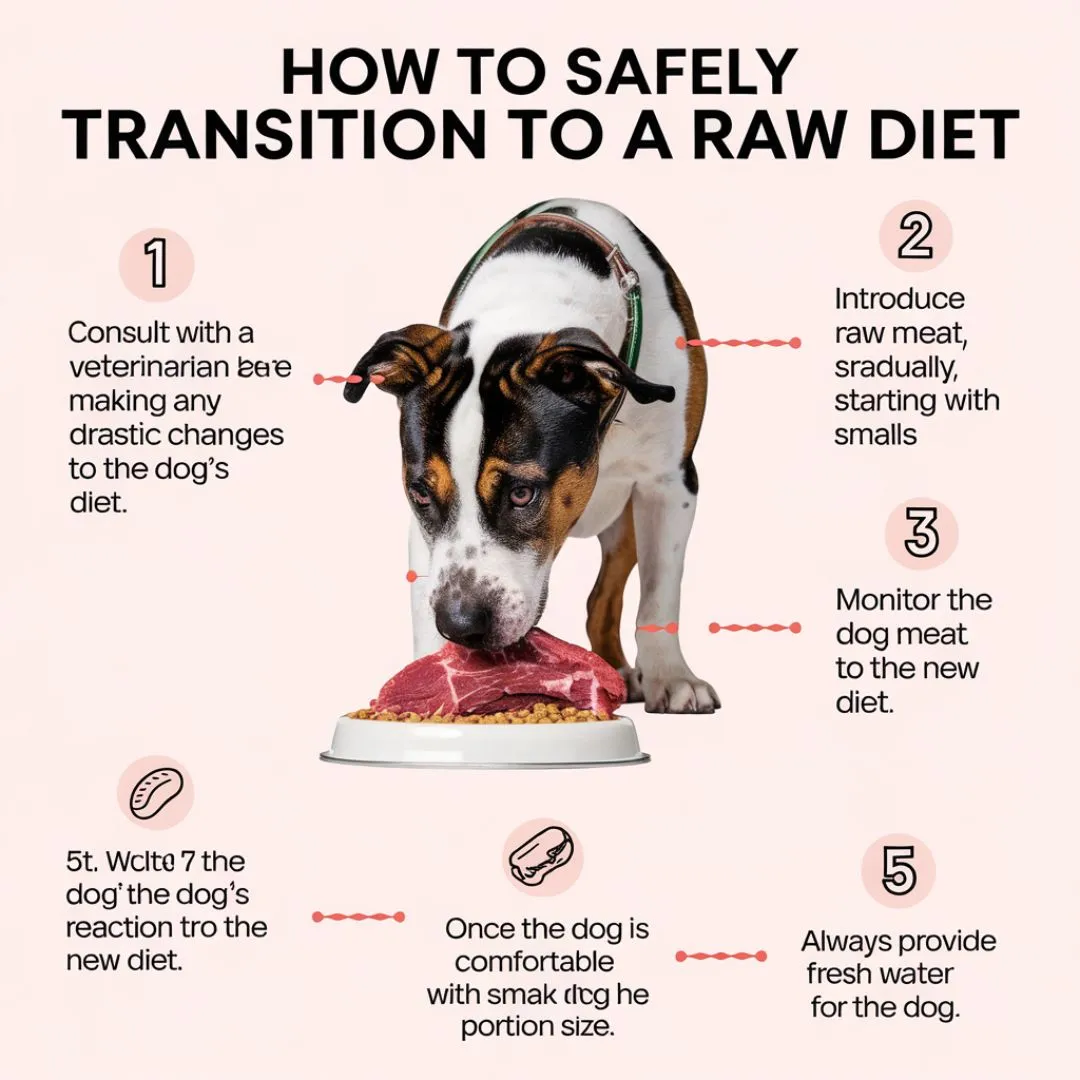Is a Raw Diet Good For Dogs with Food Allergies?
Raw food diets, often called BARF (Biologically Appropriate Raw Food), have gained popularity among pet owners seeking natural ways to manage their dog’s allergies. While many advocates claim raw diets can alleviate allergy symptoms, improve digestion, and enhance overall health, there are essential considerations and potential risks to keep in mind.
Scientific evidence on the effectiveness of raw dog food diets for allergies remains limited. Additionally, improper preparation may lead to bacterial contamination or nutritional imbalances. Before switching your dog allergies to a raw diet, consulting a veterinarian is crucial.
Understanding Is Raw Food Good for Dogs with Allergies
What Are Food Allergies?
Food diets dog allergies occur when their immune system overreacts to specific ingredients, treating them as harmful invaders. The reaction may cause various symptoms, including:
- Itchy skin and rashes
- Chronic ear infections
- Gastrointestinal issues (diarrhea, vomiting, bloating)
- Excessive paw licking and face rubbing
Common Food Dogs Allergies
In many commercial dog foods, some ingredients can cause allergic reactions in dogs. Some of the most common allergens include:
- Grains (wheat, corn, soy)
- Dairy products (lactose intolerance and casein allergies)
- Proteins (chicken, beef, eggs, pork)
- Artificial additives and preservatives
How Are Food Allergies Diagnosed?
Veterinarians often use elimination diets to identify food diets dog allergies. This involves feeding a hypoallergenic diet for 8-12 weeks, then gradually reintroducing ingredients to determine which causes allergic reactions. Other diagnostic methods include:
- Blood tests
- Raw Dog Food for Skin allergy tests
- Veterinary-prescribed hypoallergenic diets
What Is a Raw Food Diet?

Defining the BARF Diet
BARF (Biologically Appropriate Raw Food) refers to feeding dogs raw meat, bones, organs, and vegetables instead of processed kibble. Advocates believe raw diets mimic what dogs’ ancestors ate in the wild, leading to better health and fewer allergies.
Types of Raw Food Diets
- Homemade Raw Food Diets – Freshly prepared meals at home.
- Commercial Raw Food Diets – Pre-packaged, frozen, or freeze-dried raw dog allergies food.
- Prey Model Food Diet – Whole prey animals without plant ingredients.
Common Ingredients Is a Raw Diet Good For Dogs with Food Allergies
- Raw Dog meats (beef, chicken, turkey, duck, lamb, venison, rabbit)
- Organ meats (liver, kidney, heart, etc.)
- Raw Dog bones (for calcium and dental health)
- Vegetables and fruits (carrots, spinach, apples)
- Supplements (omega-3s, probiotics, vitamins)
Potential Benefits of Raw Dog Food Allergies
Eliminating Common Allergens
Since raw diets exclude grains, artificial additives, and fillers, many allergic reactions may be avoided.
Improved Skin & Coat Health
[Does a Raw Dog Food Help with Allergies]
Raw dog food allergies contain natural omega-3 and omega-6 fatty acids, which can help reduce itching and promote a shinier coat.
Enhanced Digestive Health [Is Raw Food Better for Dogs with Allergies]
Fresh raw dog foods contain natural enzymes that support digestion, leading to better stool consistency and fewer gastrointestinal issues.
Stronger Immune System
A diet rich in fresh, unprocessed food can reduce inflammation and boost overall immunity.
Better Energy Levels & Weight Management
Dogs on raw diets often experience increased energy levels and healthier body weight due to the absence of fillers and carbohydrates found in kibble.
Risks and Considerations of Raw Diets for Allergic Dogs
Bacterial Contamination Risks
Bacteria can be carried by raw meat, such as Salmonella and E. Coli, which place pets and humans at risk. Safe handling practices are essential.
Nutritional Imbalances
Homemade raw diets may lack essential nutrients if not properly balanced. Supplementing with vitamins and minerals is crucial.
Potential Digestive Upset
Some dogs may have difficulty adjusting to raw food, leading to diarrhea or vomiting during the transition phase.
Cost and Convenience
Raw feeding can be more expensive than kibble and requires proper storage and meal prep.
Not Suitable for Every Dog
Certain dogs, such as puppies, seniors, or those with metabolic diseases, may not tolerate raw diets well.
How to Transition a Dog to a Raw Diet Safely

Gradual Introduction
- Start by mixing small amounts of raw food with the dog’s current diet.
- Increase the raw portion over 7-10 days while monitoring for reactions.
Portion Control and Meal Planning
- Feed 2-3% of the dog’s body weight daily in raw dog food.
- Adjust portions based on activity level and health status.
Choosing the Right Proteins
- Begin with a single protein source (e.g., turkey or rabbit) to monitor allergic reactions.
- Gradually introduce new proteins over time.
Supplementation
- Add essential nutrients such as fish oil, probiotics, and calcium.
- Ensure balanced nutrition to avoid deficiencies.
Alternative Hypoallergenic Diets for Dogs
If a raw diet isn’t the right fit for your dog, don’t worry—there are plenty of other options that can help manage is raw food good for dogs with allergies. Here are some of the best alternatives:
Limited Ingredient Diets (LID)
LID dog foods are designed with fewer ingredients to minimize allergic reactions. [Does a Raw Dog Food Help with Allergies] By using a single protein source and a handful of easily digestible carbs, these diets help identify and eliminate allergens while keeping meals balanced and nutritious.
Hydrolyzed Protein Diets of [Is Raw Food Better For Dogs with Allergies]
These specially formulated diets take proteins and break them down into smaller molecules, making it nearly impossible for your dog’s immune system to recognize them as allergens. It reduces the chances of triggering an allergic reaction.
Home-Cooked Diets
Some pet owners opt for homemade meals to have full control over ingredients. With guidance from a veterinarian or pet nutritionist, a balanced, home-cooked diet can reduce exposure to allergens while ensuring proper nutrition.
Air-dried and Freeze-Dried Raw Diets
If you’re looking for a compromise between raw feeding and convenience, air-dried or freeze-dried raw diets are a great alternative. They offer the nutritional benefits of raw dog food without the risks of bacterial contamination, making them a safer and more practical option.
Expert Opinions & Scientific Research on Raw Diets
What Do Veterinarians Say?
The debate over raw diets continues in the veterinary world. While holistic vets often advocate for raw feeding, traditional veterinarians may warn against potential risks such as bacterial infections and nutritional imbalances.
What Does the Science Say?
Although research on raw feeding is still developing, some studies suggest benefits for allergies and digestion. However, more comprehensive research is needed to confirm these findings.
Real-Life Success Stories [Is Raw Food Good For Dogs With Skin Allergies]
Many pet owners have shared testimonials about their dogs thriving on raw diets. Reports of improved skin health, better digestion, and increased energy levels are common among those who make the switch.
Common Myths & Misconceptions About Raw Feeding
Myth: Raw Food is Dangerous Due to Bacteria
Truth: With proper handling and storage, the risk of bacterial contamination can be significantly reduced. Many dogs have stronger stomach acid that helps kill harmful bacteria.
Myth: Raw Diets Lack Essential Nutrients
Truth: A well-planned raw diet, supplemented as needed, can provide complete and balanced nutrition.
Myth: Cooking is Always Better Than Raw Feeding
Truth: While cooking can be beneficial for some dogs, raw feeding preserves more natural nutrients that may be lost during the cooking process.
FAQs: Is Raw Food Good for Dogs with Allergies?
Q1.Can raw food completely cure my dog’s allergies?
Ans. Not necessarily. While raw diets can help eliminate common allergens, they don’t guarantee a complete cure. Some dogs may still react to certain proteins.
Q2. How long does it take to see improvements after switching to a raw diet?
Ans. Many owners report positive changes in their dog’s health within 4-6 weeks, though every dog is different.
Q3. What’s the best protein for dogs with allergies?
Ans. Novel proteins like venison, duck, rabbit, and kangaroo are recommended since they’re less commonly found in commercial pet foods.
Q4. Are commercial raw food brands better than homemade raw diets?
Ans. Both have pros and cons. Commercial raw food is convenient and balanced, while homemade raw diets give you full control over ingredients. Always consult a vet before deciding.
Q5. Can puppies and senior dogs eat raw food?
Ans. Yes, but with caution. Puppies need precise nutrition for growth, and senior dogs allergies may require adjustments based on their digestive health. A vet can help guide the transition.
Q6. What are the risks of feeding raw food to dogs with allergies?
Ans. Potential risks include bacterial contamination, nutritional imbalances, and digestive upset if not introduced properly. Safe handling and supplementation are key.
Q7. Should I mix raw food with kibble during the transition?
Ans. Yes! Gradually introducing raw food alongside kibble over 7-10 days helps prevent digestive issues and allows your dog to adjust.
Q8. What are some alternative diets if raw food doesn’t work?
Ans. Hypoallergenic diets, limited-ingredient diets (LID), hydrolyzed protein diets, and home-cooked meals are all excellent alternatives for dogs with allergies.
Conclusion of Is Raw Food Good for Dogs with Allergies
Raw diets can be a game-changer for dogs with allergies, helping to eliminate common triggers like grains, artificial additives, and preservatives. Many pet owners have seen improvements in their dogs’ skin, digestion, and overall health after making the switch. However, raw feeding isn’t without risks, including bacterial contamination and potential nutritional imbalances. That’s why consulting with a veterinarian is crucial before making major dietary changes.
If raw food isn’t the right fit, don’t worry—alternative hypoallergenic diets can also help manage allergies effectively. The key is to find a diet that meets your dog’s unique nutritional needs while keeping allergic reactions under control.

